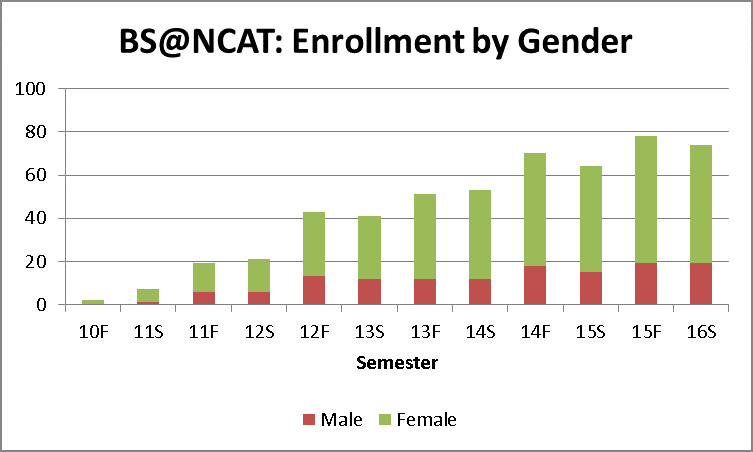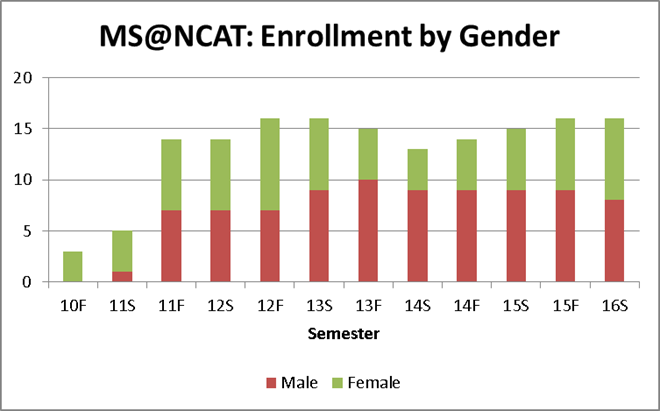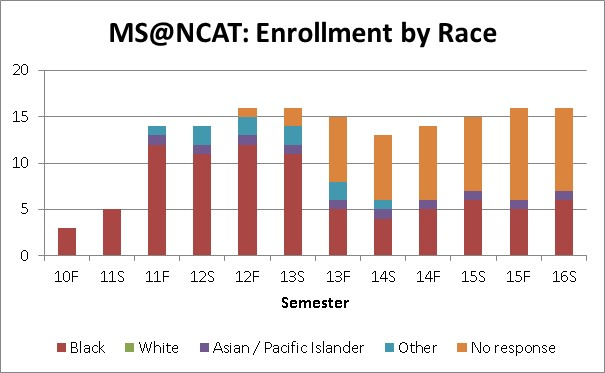2015-2016 Education and Outreach Highlights
Education Programs:
- NCAT history-making enrollment/graduation of BS and MS students as 1st seamless offering of undergraduate and graduate bioengineering programs at an HBCU.
- The current (Spring 2016) enrollments are MS: 16 (50 % female, 38 % African-American and 57 % students choosing not to provide race/ethnicity information to the University), and BS: 74 (74 % female, 74 % African-American). Since their inception in Fall 2010, the BMEN degree programs have graduated: MS 13 (46 % female) and BS 9 (67 % female). Many students have successfully found employment in industry (Baxter International, St. Joseph’s), graduate and/or professional schools and post-doctoral fellowships (Pitt, Penn State, UC, Univ. of North Carolina – Chapel Hill, Univ. of Utah, Univ. of Virginia, Rutgers). Longitudinal data showing growth in enrollment and student demographics are presented in the graphs that follow.




ERC-initiated Bioengineering Programs at NCAT:
- Co-sponsored 2015 Materials in STEM Workshop – Cocoa Beach, FL – in partnership with the Materials Education Center at Edmonds Community College (RMB outreach partner institution)
- Trans-ERC Course Offerings
- Spring 2015 – Fundamental Principles of Metallic Alloys for Biological Applications (Dr. P. Kumta, Pitt) – 6 graduate students from NCAT and Pitt
- At UC, during each school year: multiple courses are offered by ERC faculty and staff members (including Chemical Sensors, Nanoscience and Technology, Nanoscale Devices, Nanobiotechnology, and Advanced Computational Biology)
- Strong and diverse seminar series – academic year and summer – intramural speakers included faculty, students and research scholars from RMB as well as non-ERC departments/schools, extramural speakers included clinicians, entrepreneurs, government agency research managers, and visiting scholars
- Special trans-ERC seminars to all students and faculty on innovation ecosystems, entrepreneurship, business models, etc.
- The Journal Club initiated during Year 07 at NCAT by Dr. Trisha Sain and Dr. Narayan Bhattarai initiated was continued during Year 08 by SLC Leadership (Paul McGhee and Ashley Jackson) for ERC research students to have a deep discussion of review papers and the status of the topics at the global level
- Student satisfaction and learning growth for the trans-ERC courses, seminar series and outreach activities were assessed by the team of Dr. Robin Liles, Professor, School of Education
- The Education Advisory Board (EAB) for the ERC and Bioengineering Programs at NCAT continues to be active in reviewing and guiding the ERC’s education and outreach activities. Initiated and conducted the fourth and fifth Educational Advisory Board Meetings (EAB) at NCAT on March 19, 2015, leading to discussion on integrating research, education, outreach and diversity.
Outreach Programs:
All of RMB’s outreach programs had a very strong emphasis on diversity and broadening participation. Numbers are summarized below, but full demographic details are provided in the related sections of this document.
REUs:
- Between 2009 and 2015, RMB’s REU programs have served a total of 48 unique (i.e. non-returning for a second time) participants, plus return summer REUs by 3 of these (total of 51, 4 in Year 08). They have attracted a diverse population in terms of gender, race, and ethnicity, from 12 states and 21 total institutions. An emphasis was placed on recruitment from RMB’s principal outreach partners including California State University – Los Angeles (an HSI) and Guilford Technical Community College (GTCC) in Greensboro.
YSs:
- Between 2009 and 2015, RMB’s YS programs have served a total of 18 unique participants, plus return summer YSs by 3 of these (total of 21, 2 in Year 08). They have attracted a diverse population in terms of gender, race, and ethnicity, from 13 total secondary institutions in North Carolina. An emphasis was placed on recruitment from RMB’s principal K-12 outreach partner: Guilford County Schools. The 2 YS participants for 2015 were both girls, one each from Guilford County and the adjoining Forsyth County.
RETs:
- Exceptional interactions with Guilford County Schools System (serving Greensboro, NC and neighboring towns) and as well as with local community colleges (Guilford and Forsyth Technical Community Colleges) for 2 plus 2 program initiatives.
- Between 2009 and 2015, RMB’s RET programs have served a total of 27 unique (never participated before) participants, plus return summer RETs by 13 of these (40 total). They have attracted a diverse population in terms of gender, race, and ethnicity, from 19 total secondary institutions, most in North Carolina and two schools in Illinois. An emphasis was placed on recruitment from RMB’s principal K-12 outreach partner: Guilford County Schools. The charts below represent the diversity.
- NCAT collaborated closely with K-14 partner EDCC in organizing a successful 2015 Materials in STEM Workshop in Cocoa Beach, FL attended by 81 K-14 and university educators from across the nation.
B.R.A.I.N. Games (Bioengineering Recuiting and Interactive Network):
- Coordinated by Dr. Matt McCullough and Prof. Alford, sixteen high school students experienced the STEM educational modules (developed by RET participants and the YS participants) on July 28, 2015.
Informal Educational Outreach (number of participants):
- # STEM teachers: Visiting / visited by RMB researchers: 45
- # K-12 students: Visiting / visited by RMB researchers: 977
- Visitors from industry/legislative/executive/entrepreneur/academia to RMB (~100)
University of Cincinnati
- Multiple undergrad/grad courses offered by ERC facultyand staff members
- Hosted
- Multiple workshops, some related to diversity
- ~1,000 informal education visitors (students, parents, international visitors) during reporting period
- Multiple outreach interactions with Mouth Healthy Junior High School Science class by ERC graduate students and multiple faculty (Pixley, Heineman).
ERC Student Activities
Publication of seventh ERC-RMB Newsletter - produced entirely by the Student Leadership Council
ERC-RMB Student Retreats were organized during the reporting period
Student Accomplishments – Translational Activities during 2015-2016
Students from the ERC-RMB continued to achieve highly over the past year, demonstrating progress in research and entrepreneurship with numerous papers published in peer-reviewed journals, victories in poster competitions, and success at various business presentation competitions. Below are select accomplishments from students from each university.
North Carolina A&T State University
- Mr. Udhab Adhikari gave a technical presentation on his publication entitled “Synthesis and Characterization of Chitosan-Mg-based Composite Scaffolds for Bone Repair Applications” at the 2015 American Society of Mechanical Engineering International Mechanical Engineering Congress and Exposition.
- Ms. Merrie P. Foster gave a technical Ted-Talk style presentation entitled “In-Vitro Cardio-Active Drug Screening using a Stretchable Microelectrode Array” at the technical research exhibition of the 42nd Annual Convention of NBSE.
- Ms. Ashley Jackson was awarded the BME Innovation and Career Development Award which provided full registration and travel stipend to attend the 2015 BMES Annual Meeting in Tampa, FL. Ashley was the lead author of “Biomechanics: A Frontier Microbial Biotechnology” published in the Journal of Microbial & Biochemical Technology.
- Mr. Shalil Khanal gave a poster presentation entitled “Chitosan-Coated PLGA Nanoparticles for Drug Delivery at the 2016 Nano-Manufacturing Conference.
- Ms. Lumei Liu and along with Ms. Juan Wang received the trainee award for their abstract submission to the 10th World Biomaterials Congress in Montreal, Canada in May 2016. The abstract submission is entitled “A Systematic Comparison of Biodegradation Behavior of Absorbable Metal: In Standardized Immersion, Arterial Bioreactor and In Vivo study”.
- Mr. Jun Ma successfully defended his Master’s Thesis entitled “In Vitro Biocompatibility Evaluation of biodegradable Metals for Cardiovascular Stent Application”. Jun Ma was the lead author of “Similarities and Differences in Coatings for Magnesium-Based Stents and Orthopaedic Implants” published in the Journal of Orthopaedic Translation, “Sirolumus-Eluting Dextran and Polyglutamic Acid Hybird Coatings on AZ31 for Stent Applications” published in the Journal of Biomaterials Applications, “Biphasic Responses of Human Vascular Smoot Muscle Cells to Magnesium Ion” published in the Journal of Biomedical Material Research Part A, and “Bio-Adaption Between Magnesium Alloy Stent and the Blood Vessel: A Review” published in the Journal of Materials Science & Technology. Jun also presented his work entitled “The Cellular Responses of Smooth Muscle Cells to Magnesium Ion” at the 4th Annual College of Engineering graduate poster competition where he placed first place.
- Mr. Paul McGhee gave a technical presentation on his publication entitled “Directional-Tribological Investigation of Magnesium Alloys Under As-Cast and Hot Extrusion Conditions” and a poster presentation entitled “An Investigation of the Tribological Behavior of Mg and Mg-Zn-Ca-RE Alloy” at the 2015 American Society of Mechanical Engineering International Mechanical Engineering Congress and Exposition.
- Mr. Nava Rijal successfully defended his Master’s Thesis entitled “Composite Hydrogel-Based Encapsulates for Biomedical Applications”. Nava was lead author of “Chapter 12: Production of Electrospun Chitosan for Biomedical Applications” published in Elesevier. Nava received a $5000 grant to host a Biomaterials Day 2016 at NC A&T from the Society for Biomaterials. Nava gave a technical presentation on his publication entitled “Magnesium Incorporated Polycaprolactone-Based Composite Nanofibers” at the 2015 American Society of Mechanical Engineering International Mechanical Engineering Congress and Exposition.
- Mr. Jim Shi is currently working as a technology manager at Wieland Copper Products, LLC, North Carolina Area.
- Ms. Juan Wang along with Lumei Liu won the trainee award for their abstract submission to the 10th World Biomaterials Congress in Montreal, Canada in May 2016. The abstract submission is entitled “A Systematic Comparison of Biodegradation Behavior of Absorbable Metal: In Standardized Immersion, Arterial Bioreactor and In Vivo study”.
- Mrs. Adrienne Williams successfully defended her Master’s Thesis entitled “Micro-Computed Tomography-based Finite Element Analysis of the Mechanical Integrity of In Vivo Biodegradable Mg-alloy Screw & Surrounding Bone”. Adrienne presented her work on “Evaluating the Axial Pullout Performance of In Vivo Biodegradable Magnesium-Alloy and Copolymer Screws in Woven Bone using Finite Element Analysis” at the 2015 NC A&T Graduate Student Advisory Council graduate poster competition and won second place.
University of Pittsburgh
- Mr. Kacey Catt co-founded Interphase Materials, a start-up company focusing on creating nontoxic materials and coatings with sustainably derived products to build interfaces between hardware and its environment. Interphase Materials was accepted into start-up accelerator, AlphaLab Gear to receive investment, mentorship, working space, and other resources.
- Dr. Kathryn Farraro, advised by Dr. Savio Woo, traveled to Beijing to collaborate with Beijing Naton Technology Group, a leading orthopedics company in China to further develop her ACL repair devices.
- Mr. Jingyao Wu won 1st Prize in the 10th Chunhui Cup Innovation and Entrepreneurship Competition, U.S. Division for his vascular stent project. He visited several major cities in China as a winner of the competition, and discussed with government officials, entrepreneurs, and investors on the commercialization of the technology.
- Mr. Jingyao Wu and Dr. Da-Tren Chou were part of a team that took home first place at the Pittsburgh Health Innovation Case Competition (PHICC) at the University of Pittsburgh in April, 2014. They presented their recommendation for entry into the healthcare industry for a consumer device company to a group of judges which included health care professionals, entrepreneurs, and consultants. Their award for winning 1st place included a cash prize of $4,000.
- Dr. Andrew Brown successfully defended his Doctoral Thesis entitled, “Development and Characterization of a Magnesium/Polymer Composite for Guided Bone Regeneration”.
- Dr. Amy Chaya successfully defended her Doctoral Thesis entitled, “Development and Testing of Degradable Magnesium Alloys for Bone Fracture Healing”. Amy was second author on the publication “An in vivo model to assess magnesium alloys and their biological effect on human bone marrow stromal cells” in Acta Biomaterialia.
- Dr. Kathryn Farraro successfully defended her Doctoral Thesis entitled, “Regeneration of the Anterior Cruciate Ligament Using Resorbable Metallic and Extracellular Matrix Bioscaffolds”. Dr. Farraro was first author of the publication “A magnesium ring device to restore function of a transected anterior cruciate ligament in the goat stifle joint” in Journal of Orthopaedic Research.
- Dr. Daeho Hong successfully defended his Doctoral Thesis entitled, “Fundamental Study of the Design and Development of Magnesium-Zinc Based Alloys for Biodegradable Implant Devices”. Dr. Hong was co-author of the publication, “In vivo monitoring the biodegradation of magnesium alloys with an electrochemical H2 sensor” in Acta Biomaterialia and “Synthesis and electrochemical study of Mg 1.5 MnO 3: A defect spinel cathode for rechargeable magnesium battery” in Materials Science and Engineering: B.
- Dr. Da-Tren Chou successfully defended his Doctoral Thesis entitled, “Fundamental study of the development and evaluation of biodegradable Mg-Y-Ca-Zr based alloys as novel implant materials”.
- Mr. Kacey Catt co-authored two articles: “In Vivo Electrochemical Analysis of a PEDOT/MWCNT Neural Electrode Coating” in Biosensors and “Chronic In Vivo Evaluation of PEDOT/CNT for Stable Neural Recordings” in IEEE Transactions on Biomedical Engineering.
- Alumni Dr. Satish Singh was first author on the paper: “In Vivo Electrochemical Analysis of a PEDOT/MWCNT Neural Electrode Coating” in Materials Science and Engineering: C.
- Alumni Dr. Danielle Minteer was co-author on the paper: “Combining micro-computed tomography with histology to analyze biomedical implants for peripheral nerve repair” in Journal of Neuroscience Methods.
University of Cincinnati
- Mr. Daoli Zhao was able to demonstrate a visual sensor for H2 based on a material that changes color when exposed to H2. The sensor monitors in vivo corrosion of Mg by H2 that permeates through mouse skin. The visual sensor detected relative corrosion rates of three different Mg alloys (Dr. Kumta’s lab) with corrosion rates that vary from slow to fast. Moreover, quantization of the color response of the H2 visual sensor was established using ImageJ software to measure brightness that was calibrated with the electrochemical H2 sensor. The visual sensor offers the advantages of adequate sensitivity for ERC applications, low-cost, ease of use, ruggedness, quantitative, and non-invasive. H2 in bone marrow from a biodegrading Mg implant has been measured for the first time in a rabbit bone fracture study performed with Dr. Sfeir at UPitt. The electrochemical H2 sensor was used for H2 measurements transdermally to monitor biodegradation of an implanted plate and inside the bone marrow to monitor the screw tip biodegradation. The H2 needle sensor was able to easily detect H2 in bone marrow where the H2 level was found to be very high (exceeding a saturated water solution), suggesting that H2 generated in situ was trapped in bone marrow. The results correlate with the bone healing process. The in vivo corrosion products of Mg alloys from NCAT (Dr. Yun), Pittsburgh (Dr. Kumta) and UC (Dr. Shanov) in conjunction with Dr. Dong’s subcutaneous mouse studies were characterized by monitoring hydrogen transdermally with a hydrogen sensor, determining surface corrosion products on explanted samples using X-ray photoelectron microscopy, and measuring Mg and Zn alloy ion distribution in mouse organs and tissue surrounding the implant using inductively coupled plasma mass spectrometry (ICP-MS). ICP -MS analysis shows that there is no unusual or toxic accumulation of magnesium and zinc in these studied organs.
- Mr. Kolade Ojo has published a paper “Ojo, K., Kuhlmann, J., Hopkins, T., Heineman, W.R. , Pixley, S.K., Electroanalysis. in Press 2016”, he also attended PITTCON 2016, Atlanta GA conference.
- Mr. Chenhao Xu graduated from University of Cincinnati with Master of Science degree in mechanical engineering. He will continue in PhD. study at the same area. He designed a new angle-shape stent for fully coverage of the AV fistula region. The new stent expansion model was simulated in Abaqus. The new design was fabricated with AZ31 alloys for mechanical verification and in vivo test in future; at the same time, the Gen. III stents were manufactured with ERC-PL magnesium alloys which was developed by University of Pittsburgh student Jingyao Wu. In addition, he attended the outreach activities in Mt. Healthy High School in Cincinnati.
- Mr. Yonghai Zhang developed a prototype wireless corrosion control device, which was manufactured with help of Ke Li, a visiting scholar from China, for his smart biodegradable implant project. He performed proof of concept experiments of the wireless corrosion control prototype in a porcine model in collaboration with Dr. Pabir’s AV Fistula development team.
- Mr. Guangqi Zhang kept the growth of Magnesium single crystals during Year 8 and have increased the size of the as grown Mg single crystal to 150 mm in length and 20 mm in diameter. Laue X-ray diffraction was performed to confirm the single crystallinity of the super large single crystals.
- Mr. Pravahan Salunke studied the mechanism of mechanical deformation of Mg single crystals. He is also working on the application of Mg single crystals in various biomedical implants such as ACL rings, orthopedic plates, screws as well as vascular stents. Recently he submitted a paper titled “Apparatus for Growing of Magnesium Single Crystals Used in Biomedical Applications” in the ‘Review of Scientific Instruments’ journal.
- Ms. Tarannum Tiasha worked on the design and fabrication of Mg AZ31 staples for craniofacial applications. Staples of a more complicated design are currently being developed for a different application. She is also working on design and fabrication of a composite Nitinol-Mg stent in collaboration with Dr. William Wagner’s group at UPitt. A paper titled “Biodegradable, elastomeric coatings with controlled anti-proliferative agent release for magnesium-based cardiovascular stents” was published (31 March,2016) in the journal “Colloids and Surfaces B: Biointerfaces” in which Tarannum Tiasha was a co-author. Participation in National and International Conferences
Participation in National and International Conferences
The ERC-RMB continues to be well represented in domestic and international conferences by its student body. A list of conferences where students presented their work in a platform or poster presentation is shown below.
- 2015 American Society of Mechanical Engineering International Mechanical Engineering Congress and Exposition, Houston, Texas
- 2015 Tissue Engineering and Regenerative Medicine International Society (TERMIS) World Congress, Boston, MA
- 2015 Biomedical Engineering Society Annual Meeting, Tampa, FL
- 2016 Pittcon, Atlanta, GA
- 2016 American Association for Dental Research, Los Angeles, CA
- 2016 National Society of Black Engineers Annual Convention, Boston, MA
- 2016 University of Pittsburgh Bioengineering Day, Pittsburgh, PA
- 2016 Biomaterials Day, North Carolina A&T State University, Greensboro, NC
- 2016 Nano-Manufacturing Conference, Joint School of Nanoscience and Nanoengineering, Greensboro, NC
- 2016 10th World Biomaterials Congress, Montreal, Canada
- 2016 8th Symposium on Biodegradable Metals, Montreal, Canada
- 2016 PITTCON CONFERENCE & EXPO, Atlanta, GA
- 2016 42nd Annual Convention of National Society of Black Engineering, Boston MA

